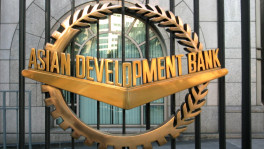Green growth: A panacea or an eyewash?
It can be a pioneering and revolutionary approach to address social and environmental issues. However, there are some caveats

The conceptualisation of the 'green economy,' as flamboyant as it sounds, has drawn various controversies and debates for the past decades, and more so because it challenges the discourse of archetype monetary models of economic growth that have been perpetuated during the previous decades.
Popular definitions of green economy contain popular terms such as 'low carbon,' 'resource efficient,' and 'inclusive'— all wrapped in the elusive package of 'sustainability.'
In a world fragmented by existential crises such as climate change, global pandemics and consistently high levels of environmental degradation coupled with resource depletion, it is surprising that the 'green economy' already bundle presents itself as a panacea—a one-stop solution to all problems.
It is argued that a newer, more sustainable green economy will inevitably have a transformative approach towards traditional economic growth, and here enters a strategy coined as 'green growth.'
The term 'green growth' gained widespread acceptance at the 2012 United Nations Conference on Sustainable Development in Rio de Janeiro.
It is pitched as an innovative and ground-breaking strategy based on the premises of technological breakthrough, enabling policies and market-driven mechanisms.
One which appears to be perfectly aligned with the sustainable development goals (SDGs), as it addresses both social and environmental concerns.
But there appear to be some questions, as the natural resources are limited.
How can green growth lead to equitable economic gains in a way that does not adversely impact the environment? How can policy interventions bring about changes in consumption patterns, fueled by a green industrial strategy?
The green growth theory has multiple critiques and theoretical flaws.
The fault lines
One flaw is that it has failed to deliver better outcomes on certain indicators such as happiness, health, environmental sustainability and overall well-being. It is vital to understand the environmental threats posed by unrestrained growth.
While green growth argues for technology and enabling policy frameworks as the right initiatives to initiate and sustain growth, the absolute 'decoupling' of GDP from the use of natural resources seems like a far-fetched idea.
Sceptics of the green growth concept argue that while green growth may promise to curtail and even significantly drive down carbon emissions, it will continue to exacerbate the damage caused by the incessant exploitation of natural resources to meet current needs.
Advocating for 'degrowth' rather than green growth, they argue that the green economy is simply an eyewash that retains major components of conventional economic growth.
The need for efficiency
For the world to at least attempt to remain within arm's length of the target to restrain global temperature rise to 1.5°C, it has to maximise resource efficiency. We must implement policies that coordinate and monitor actions to elevate resource efficiency.
There should be a shift towards a circular economy which seeks to minimise resource use by reusing and recycling. By default, it curbs waste and pollution by keeping products and materials in use for the longest possible time.
Avoiding overconsumption or underconsumption
To avoid the presence of externalities (ie, overproduction leading to overconsumption and vice versa), it is vital to consume so that a state of sufficiency is achieved. Sufficiency ensures that the right quantity of commodities required for optimal well-being is consumed, thus eliminating poverty or overconsumption (environmental degradation).
Irrespective of the level of growth, sufficiency will ensure the optimum and equitable level of production needed to ensure human and environmental well-being. Sufficiency, therefore, overlaps the principles of green growth to some extent. But it must be understood that in line with the proposition put forth by the concept of 'degrowth,' the primary responsibility lies with advanced countries, as they must substantially reduce their consumption and, consequently, their substantial emissions.
However, attaining sufficiency does not completely transgress green growth. It is possible to attain a certain level of green growth if the practical implementation of decoupling economic growth from resource consumption involves imposing complete or partial restrictions on the utilisation of non-renewable resources.
For instance, this could involve imposing a limit on aggregate carbon emissions specific to each country.
Addressing inequality
As a precondition for sufficiency, there is a need for wealth and resource redistribution, both within and across nations, to ensure equitable access for common well-being. The concentration of wealth in the hands of a meagre percentage needs to be avoided at all costs, and the public sector must also strive for efficiency in the production and distribution of public goods and services, including health and education.
Case study: Bangladesh
The concept of 'green economy' today is no longer restricted to the fundamentals of environmental economics but rather has emerged as a popular and frequently debated area of policy discourse.
Centring around a new economic paradigm that strongly advocates against economic expansion at the cost of environmental degradation, resource depletion and ecological destruction, the concept of a green economy in Bangladesh specifically calls out for greater public-private engagement and interaction.
Private finance is very limited in the contextualised climate change discourse of Bangladesh. In fact, private sector finance for climate resilience and adaptation is not at all commensurate with the externalities generated by production lines in private corporations.
As such, a major share of the contribution needs to come from public financing of climate change. In the Bangladesh context, almost all monetary disbursements come from national organisations, and private sources of financing are strictly limited (World Bank, 2014).
The private sector has been actively advocating for good governance in the country. However, the otherwise thriving private sector has yet to implement initiatives to prepare for future climate-induced hazards or safeguard their investments.
A very important constraint in private sector engagement in climate change-related projects is the lack of capacity to evaluate or assess them, which in turn is an outcome of their lack of understanding of climate change investments and risk profiles, as well as their inability to identify stakeholder or beneficiary groups.
What to do?
To be successful in the compound context of developing countries, green growth strategies must be complemented by relevant policies that aim to redress the aforementioned structural features. Progressive policy reforms that seek to facilitate backward and forward linkages for primary production, create sustainable markets, and provide ample space for knowledge-centric innovation can help alleviate poverty and perpetuate inequality.
Conclusively, a green economy must aim for the decentralisation of green jobs and employment to reduce high rates of rural-urban migration, which can therefore reduce the pressure on limited urban resource landscapes.

Lamia Mohsin is a young professional and researcher. She is an Oxfam Young Fellow working on youth climate advocacy
Disclaimer: The views and opinions expressed in this article are those of the authors and do not necessarily reflect the opinions and views of The Business Standard


 Keep updated, follow The Business Standard's Google news channel
Keep updated, follow The Business Standard's Google news channel















